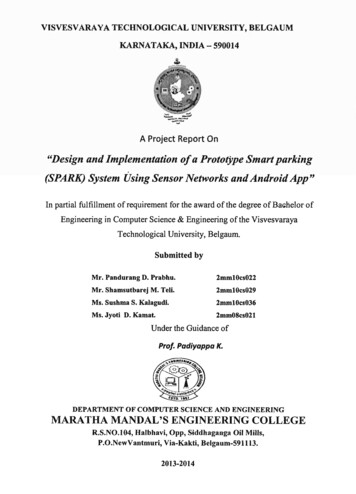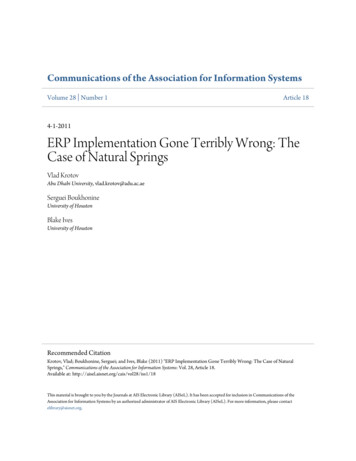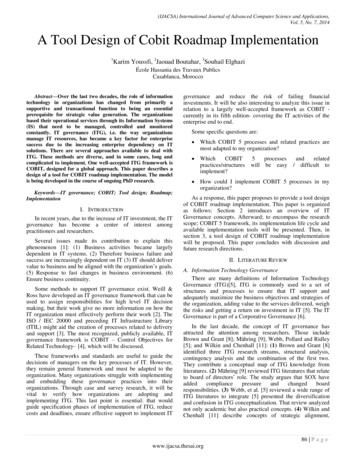
Transcription
VISVESVARA YA TECHNOLOGICAL UNIVERSITY, BELGAUMKARNATAKA, INDIA - 590014A Project Report On"Design and Implementation of a Prototype Smart parking.(SPARK) System Using Sensor Networks and Android App"In partial fulfillment of requirement for the award of the degree of Bachelor· ofEngineering in Computer Science & Engineering of the VisvesvarayaTechnological University, Belgaum.Submitted byMr. Pandurang D. Prabhu.2mmlOcs022Mr. Shamsutbarej M. Tell.2mmlOcs029Ms. Sushma S. Kalagudi.2mmlOcs036Ms. Jyoti D. Kamat.2mm08cs021Under the Guidance ofProf. Padiyappa K.DEPARTMENT OF COMPUTER SCIENCE AND ENGINEERINGMARATHA MANDAL'S ENGINEERING COLLEGER.S.NO.I04, Halbhavi, Opp, Siddhaganga Oil Mills,P.O.NewVantmuri, Via-Kakti, Belgaum-591113.2013-2014
I VE V RAY A TECHNOLOGICAL UNIVERSITY, BELGAUMKARNATAKA, INDIA - 590014A Project Report On"Design and Implementation of a Prototype Smart parking(SPARK) System Using Sensor Networks and Android App"Sponsored by KSCST Student Programme (SPP).In partial fulfillment of requirement for the award of the degree of Bachelor ofEngineering in Computer Science & Engineering of the VisvesvarayaTechnological University, Belgaum.Submitted byMr. Pandurang D. Prabhu.2mmlOcs022Mr. Shamsutbarej M. Teli.2mmlOcs029Ms. Sushma S. Kalagudi.2mmlOcs036Ms. Jyoti D. Kamat.2mm08cs021Under the Guidance ofProf. Padiyappa K.DEPARTMENT OF COMPUTER SCIENCE AND ENGINEERINGMARATHA MANDAL'S ENGINEERING COLLEGER.S.NO.I04, Halbhavi, Opp, Siddhaganga Oil Mills,P.O.NewVantmuri, Via-Kakti, Belgaum-591113.2013-2014
MARATHA MANDAL'S ENGINEERING COLLEGER.S.NO.I04, Halbhavi, opp, Siddhaganga Oil Mills,P.O.NewVantmuri, Via-Kakti, Belgaum-591113.DEPARTMENT OF COMPUTER SCIENCE & ENGINEERINGCERTIFICATECertified that the project work entitled"Design and Implementation of a Prototype Smart parking(SPARK) System .Using Sensor Networks and Android App"Carried out byMr. Pandura,ng D. Prabbu.2mmlOcs022Mr. Sbamsutbarej M. Teli.2mmlOcs029Ms. Susbma S. Kalagudi.2mmlOcs036Ms. Jyoti D. Kamat.2mm08cs021In partial fulfIllment of requirement for the award of the degree ofBachelor of Engineering in Computer Science & Engineering of theVisvesvaraya Technological University, Belgaum, during academic year2013-14. It is certified that all corrections/suggestions indicated for theinternal assessment have been incorporated in the report. The projectreport has been approved as it satisfies the academic requirement in therespect of the project work prescribed for the Bachelor of EngineeringDegree. .l\OI) \,?(1\GUIDEProf. Padiyappa koogatinPRINCIPALDr. Ameet PatilDr.Vpt.ifIlrt1kV2.M. M. Engineering CoIIege,-Belgaum.
DEDICATED TOOURBELOVEDTEACHERS ANDPARENTS
ACKNOWLEDGEMENTThe sense of contentment and elation that accompanies the successful completion of thisproject would be incomplete without mentioning the names of those people who helped me inaccomplishing this project There are many people whose constant guidance, support andencouragement resulted in its realiza on.First of all we would like to thank our beloved Principal Dr. V.B.SONDUR forproviding facilities to carry out this project smoothly.we express our sincere gratitude to our Head of Deparbnent Dr. Ameet Patil , for theirhelp during this course of development of this project and am thankful for providing lab facilitiesneeded for the accomplishment of this projectThis project could not be completed, in all respects, without the inspiring guidance ofour guide. So, we express our deep sense of gratitude and hence we are greatly indebted to ourguide Prof. Padiyappa Koogati, for being constant source of encouragement and inspiration.We are also grateful to him for his eplightening guidance and watchful supervision throughoutthe course of project work.We would like to express our cordial regards to our parents for their encouragement andmoral support.Finally, we are also thankful to other friends who provide helpful criticism during thespan of the project-Project Associates
ABSTRACTWith the rapid proliferation of vehicle availability and usage in recent years, finding avacant parking space even in multi floored parking space is becoming more and more difficult,resulting in a number ofpractical conflicts. Parking problems are becoming ubiquitous and evergrowing at an alarming rate in every major c;'ty. Widespread use of wireless technologies pairedwith the recent advances in wireiess applications for parking, manifests that digital datadissemination could be the key to solve emerging parking problems. Wireless Sensor Network(WSN) technology has attracted increased attention and is rapidly emerging due to theirenormous application potential in diverse fields. This buoyant field is expected to provide anefficient and cost-effective solution to the effluent car parking problems.
CONTENTS1.INTRODUCTION12.LITERATURE SURVEY42.1 System Evaluation4REQUIREMENT SPECIFICATION73.1 Hardware Specification3.2 Software Specification77SYSTEM DESIGN84.1 System Architecture84.1.1 Architecture94.1.2 Detailed Design10tMPLEMENTATION DETAILS5.1 Driver Assistance System13135.2 Intelligent Car Parking'System5.3 Prototype System: Experimental SetupISSYSTEM TESTING6.1 Overview6.2Test Plan6.2.1 Test Cases19191921RESULTS AND SNAPSHOTS227.1 Experimental Result7.1.1 Front Screen of the Application7.1.2 Selection of the Location7.1.3 Checking of Free, Booked Or Parked Vehicle22232425CONCLUSION AND FUTURE WORK26REFERENCES273.4.s.6.7.8.16
LIST OF FIGURESFigure 1 Architecture of Parking System9Figure 2 Detailed Design10Figure 3 Assistance Steps13Figure 4 Architecture of our System1SFigure S Parking Layout (SPARK prototype model)16Figure 6 Entrance Display18Figure 7 Reserved and Parking Lot OUI18Figure 8 Parking Guidance and Experimental Results22Figure 9 Front Screen23Figure 10 Selection of Location Screen24Figure 11 Checking of Free, Booked and Parked Vehicle2S
"Design and Implementation of a Prototype Smart Parking (SPARK) System UsingSensor Networks and Android App"SYNOPSIS"Design and Implementation of a Prototype Smart parking(SPARK) System Using Sensor Networks and Android App"AimOur aim is to find a vacant parking space in multi floored parking system and providingavailable infonnation to the user.Project MembersMr. Pandurang D. Prabhu.2mmlOcs022Mr. Shamsutbarej M. Teli.2mmlOcs029Ms. Sushma S. Kalagudi.2mmlOcs036Ms. Jyoti D. Kamat.2mm08cs021Under the Guidance ofProf: PADIYAPPA KOOGATIDept of. CS MMEC Belgaum
"Design and Implementation of a Prototype Smart Parking (SPARK) System UsingSensor Networks and Android App"Present TheoryWith the rapid proliferation of vehicle availability and usage in recent years, finding avacant parking space even in multi floored parking space is becoming more and moredifficult, resulting in a number of practical conflicts. Parking problems are becomingubiquitous and ever growing at an alanning rate in every major city.Widespread use of wireless technologies paired with the recent advances in wirelessapplications for parking, manifests that digital data dissemination could be the key to solveemerging parking problems. Wireless Sensor Network (WSN) technology has attractedincreased attention and is rapidly emerging due to their enormous application potential indiverse fields. This buoyant field is expected to provide an efficient and cost-effectivesolution to the effluent car parking problems.Proposed WorkThis proposes a Smart Parking (SPARK) Management System based on sensor networktechnology which provides advanced features like remote parking monitoring, automatedguidance based on Android App. Here each sensor is placed in between parking slot of amulti floored parking building. So whenever a car gets parked in parking slot. The sensordetects it and sends the signal to the microcontroller which in turn stores it in the serverregarding the current place occupied by the car. This is same in the case when the carleaves the parking space.The Android app which is installed in the driver's smartphone gives the clear updates tothe Driver about the current free & also occupied positions of the parking spaces in theirsmartphones. So that he/she can park their car easily check current available space for theircar to be parked in the current vacant space available.Dept of. CS MMEC Belgaumii
"Desiga and ImplelDentation of a Prototype Smart Parking (SPARK) System UsingSensor Networks and Android App"Fig i. Sensor attached free space available for parking.Expected Outeome of tbe projectThe driver gets detailed information about occupied and free spaces available in theparking area through android apps. It reduces the amount of traffic while searching eachfree space for parking of the car.Applications1. This system can be implemented in the metropolitan cities where areas like ShoppingMalls, Restaurants, and Multiplexes face a lot of problems on parking system.2. It reduces the amount of traffic while searching each free space for parking of the car.3. The driver gets detailed information about occupied and free spaces available in theparking area through android apps.4. Lower investment dum the other Parking Techniques which are presently available.Dept of. CS MMEC Belgaomiii
"Design and Implementation of a Prototype Smart Parking (SPARK) System UsingSensor Networks and Android App"System RequirementsHardware specification Microcontroller Sensors Android cell LCD screenSoftware specification Sensor Networks Android Application PHP HTML Javascript CSSStudent signatures Mr. Pandurang D. Prabhu. Mr. Shamsutabrej M. Teli. .Ms. Susbma S. Kalagudi.Ms. Jyoti D. Kamat.GuidesignatureProf:p aKoogati.Dept of. CS MMEC Belgaumiv
"Design and Implementation of a Prototype Smart Parking (SPARK) System UsingSensor Networks and Android App"CHAPTERlINTRODUCTIONRecent increase in the growth of automotive industry coupled with the perpetual demandof commuters urged the need for better and smarter parking mechanisms. Though lot ofresearches were conducted in this area, most of the existing parking management systemsrarely address the issues of parking space management, vehicle guidance, parking lotreservation etc. Majority of these systems have control at the entrance & exit and usevehicle detectors as an essential element to provide smart parking. Though inductive loopis one of the most widely used detectors today, it includes various problems in installationand maintenance which might disturb the Donnal operations of parking. The widespreaduse of wireless technologies paired withthe advancement in wireless applications forparking implies that digital data dissemination could be the key for resolving the growingparking challenges. WSN have a great potential towards providing an easy and costeffective solution to this credible application for various reasons. Ease of deployment inexisting parking lots without excavation and expensive cable installations has increasedour attention towards wireless sensor network technology. Flexibility to couple withsophisticated but cheap sensors that can accurately detect vehicles' makes WSN a naturalcandidate to solve the emerging car parking problems. Wireless sensor network usually--consists of a large number of nodes that are deployed in the sensing area and are equippedwith different kinds of sensing, computation and communication units. These functionalunits enable WSN nodes to cooperatively collect, process, and transmit infonnation to thesink. Compared with the existing parking management systems. Smart PARKing(SPARK) solution based on wireless sensor network technology. The proposed system iscapable of monitoring & managing individual parking spaces, providing automatedguidance and advanced reservation services as well. Unmanned vehicle driving systemshave been developed by famous auto mobile companies for years. Regardless of the issuesof laws and regulations, there still have many technical issues, such as navigation,combination with Geographical Infonnation System (GIS), and real-time monitoring ofsurrounding environment. One of the key technical issues is how to acquire the currentposition of the vehicle accurately. Making good decisions can often mean the differencebetween life and death. In order to make critical decisions, people must be able to assesstheir current situations and have access to pertinent infonnation that addresses variablesDept of. CS MMEC Belgaum1
"Design and Implementation of a Prototype Smart Parking (SPARK) System UsingSensor Networks and Android App"upon which these decisions are based. By increasing situational awareness, individuals areable to make decisions faster and more effectively. This is especially important inemergency response and military operations, where time and quality information are of theessence. Car-park management systems operate by monitoring the availability of carparking spaces and making that infonnation available to customers and facilityadministrators. Customers use it for guiding them in their choice of parking space;administrators use it to aid in overall management and planning. Sensor networks are anatural candidate for car-park management systems, because they allow status t.o bemonitored very accurately - for each parking space, if desired. Wireless sensor networkshave the advantage that they can be deployed in existing car-parks without having toinstall new cabling for network and electricity to reach each sensing device. For thisreason, wireless sensor networks also have use for road-side car-parking. a smart parkingservice based on wireless sensor networks and mobile phone application for vehicle.drivers. We have designed and implemented a prototype system of smart parking servicesthat allows vehicle drivers to effectively find the vacant parking spaces, both in outdoorsand indoors environments. The proposed smart parking system consists of wireless sensornetworks, embedded web-server, central web-server and mobile phone application asAndroid and iPhone. In this system, low-cost wireless sensors network modules aredeployed into each parking slot equipped with one sensor node. The state of the parkingslot is detected by sensor node and is reported periodically to the embedded web-server viathe deployed wireless sensor network. And this infonnation is sent to central web-serverusing WiFi networks in real-time, and the vehicle driver can also find vacant parking lotsusing a mobile phone or a tablet. A few existing solutions focus on parking lot applicationsusing sensor technologies, such as magnetometers and video cameras. However,magnetometers are very sensitive on environmental factors, as a result of which theirdetections are not always accurate. Moreover, since magnetometers measure the change inmagnitude and direction of Earth's magnetic field caused by the presence of a vehicle,they need to be placed at close proximity to the vehicle. Although this might be possiblenear the entrance of a parking lot, it is very difficult to place them in close proximity tovehicles on upper floors simply because there are typically no entrance marked for upperfloors and vehicles move at relatively higher speeds than near the entrance. On the otherhand, video camera based solutions are energetically expensive and they can generatelarge amount of data which could be very difficult to transmit over multiple hops in aDept of. CS MMEC Belgaum2
"Design and Implementation of a Prototype Smart Parking (SPARK) System UsingSensor Networks and Andt"oid App"wireless environment. These disadvantages coupled with the fact that there are otherobjects moving in a parking lot, such as humans, greatly reduce the applicability of onlyone type of sensor technology, i.e., only magnetometers or only video cameras for cheapand accurate parking lot management solution.Dept of. CS MMEC Belgaum3
"Design and Implementation of a Prototype Smart Parking (SPARK) System UsingSensor Networks and Android App"CHAPTER 2LITERATURE SURVEY2.1 System EvaluationThe SPARK prototype system is developed as a proof of concept to meet the real timerequirements of parking management systems. We have carried out preliminaryexperiments to evaluate the functionalities and features provided by our prototype system.In our initial experiment we have odelled this prototype for 20 parking lots.1) Parking Monitoring:a) Scenario l: Total parking lots are vacant: When all the parking lots are vacant, thesensor nodes placed in the parking lots detect that there is no event generated. Theentrance display shows total vacant lots as 20 and parking lot QUI depicts.b) Scenario 2: Three cars are parked: In this scenario we experimented by parking threecars in the parking lots. The sensor nodes detected the events and transmitted the reportmessage to the sink. The sink in tum forwarded these messages to the management server.The management server processes this information and sends the status report to therespective guiding nodes and entrance display. The entrance display and parking lot QUIthen, displayed the total no of vacant lots as Device Specificationl) Sensor Node: This isthe lowest level of the system andis provided by autonomous sensor nodes as shown infigure. These small, battery-powered devices are placed in the areas of interest. Eachsensor node collects environmental data primarily about its immediate surroundings. In theprototype system we placed these nodes at every parking lot. These nodes will sense thepresence of car in the parking lot using the light sensors attached and sends the event to thesink node through RF communication. The LEOs attached with the nodes also providestatus information about the parking lots. Sink Node: Individual sensor nodescommunicate and coordinate with one another. The sensor nodes will typically form amulti hop network by forwarding each other's messages, which vastly extendsconnectivity options. Ultimately, the data from each sensor node are propagated to thegateway/sink node Status LED Display: These LED displays as are placed at each andevery parking lot. They indicate the status of parking lot. Red LED indicates that theparking lot is occupied, while the green LED indicates that the parking lot is vacant. Anyreservation of the car parking lot is indicated using the blue LED. It is inefficient forartificial guide for parking inside the garage in the traditional parking management.Parking spaces positioning and display system helps the user to find the location of theirDept of. CS MMEC Belgaum4
"Design and Implementation of a Prototype Smart Parking (SPARK) System UsingSensor Nehvorks and Android App"own parking spaces quickly, whose hardware includes: control computer, reader, RFIDtags, antennas, etc. The actual parking lot with the situation of parking spaces is drawn inthe flat electronic map in real time. Users can easily get how many spaces and how to getthere with the help of electronic map. One user getting the parking spaces positioning anddisplay terminal installed at the road side punch their parking card which is taken from theautomatic issuing machine in the entry. The terminal will highlight the parking spacewhich has been distributed. The user can find their parking space quickly according to thereminding of the terminal. The schematic diagram of the parking spaces positioning anddisplay system. Each special user will get one RFID tag, which is bounded with itspersonal information and parking information stored into the database. One car, of whichelectronic tag is installed in the proper position, will be checked through the RFID, when itenters into the coverage of electromagnetic waves emitted by antenna. If the tag is valid,entry's railing is lifted, and then the car enters into the garage without stopping; if the tagis invalid, special user has to enter into the garage as a temporary user. Graphic electronicmap of the system is simple relatively, which is just used for an illustration here. In actualusing, drawing the corresponding two-dimensional map based on the distribution ofparking spaces in different parking lots is needed. The location of the parking positioningand display terminal is installed. at the entry of the parking lot, which is convenient forusers to park and query. As shown in the deployment scheme the platform is distributed ina metropolitan space. And different parts of the platform have different softwarelhardwareplatforms, terminal mobility and other characteristics. Communications and collaborationbetween the various parts are the key issue must be resolved. We can see there are threekinds of connections in the system including connections between mobile tenninals andthe server, connections between parking subsystem and the server and connectionsbetween traffic monitors and the server. For the first one, mobile communication networkis the only choice because smart phone acts as mobile tenninal, its capability of 2.50/30. data communication providing a natural connection between mobile tenninals and2.50/30 modems attached to the server. For the second, there are several availablecommunication schemes include wired broad-band, Wi-Fi, wireless Mesh network andmobile communication to access the metropolitan area networks. To consider therelatively less data transmitting and flexible deployment requirement and lacking wiredaccessing method in most parking lots, mobile communication based on a GPRS/3Gmodem is more competent for this job. For the last one, if we transmit real-time trafficDept of. CS MMEC Belgaum5
"Design and Implementation of a Prototype Smart Parking (SPARK) System UsingSensol· Networks and Android App"monitoring video to the central server which will does the analysis work to get real-timetraffic state the cost of mobile communication traffic is unacceptable. And wiredmetropolitan-area network access point is absent often where the traffic monitor is placed.Therefore video image recognizing work is completed in traffic monitor terminal and therecognizing result is passed to the server. Then the required bandwidth is less and longtime-run cost is lower despite increase of performance requirement of monitoringterminals. To provide real-time parking information, parking lots are required to executesense, collect, transmit and distribute information about vehicle passing event andinfonnation about available parking room. Think over facts of cost and deploymentflexibility, we implement this requirement based on WSN technology. The work planincludes several key points. Firstly deploy vehicle sensors at entrances and exits to detectvehicle passing event. Secondly gather all the signals in sink node and the embeddedparking machine witch stores parking lot's initial information. Then calculate the currentnumber of available parking spaces. Last report data to remote server. To sense vehiclepassing event, there are infrared sensor, magnetic sensor and video identification method.Magnetic sensor is adopted finally for it is simple, easy to implement, low-cost and withgood anti-jamming performance to achieve vehicle detection. There are many readY-fi1,ademagnetic sensors on sale. Most of them include induction coils and a relay controlling boxand output a square-wave pulse when vehicle passes. a set of smart parking services basedon Wireless Sensor Networlcs. We design and implement a prototype system that allowsvehicle drivers to effectively find can effectively satisfy the requirements of WSN-basedparking slots monitoring service. In this system, low-cost wireless sensors networksmodule are deployed into each parking slot equipped with one sensor node. The state ofthe parking slot is detected by sensor node and is reported periodically to the embeddedweb-server via the deployed wireless sensor networks. And this information is sent tocentral web-server using Wi-Fi networks in real-time. Besides, the vehicle driver can findvacant parking lots using their mobile devices. Though this prototype system wedemonstrate that the proposed architecture can effectively satisfy the requirements ofsmart parking service and we believe that wireless sensor networks and mobile deviceapplication can be an encouraging technology to solve future parking management.Dept of. CS MMEC Belgaum6
"Design and Implementation of a Prototype Smart Parking (SPARK) System UsingSensor Networks and Android App"CHAPTER 3REQUIREMENT SPECIFICATION3.1 Hardware specification Microcontroller Sensors Android cell LCD screen3.2 Software specification Sensor Networks Android Application.PHP··HTML Java script essDept of. CS l\{MEC Belgaum7
"Design and Implementation of a Prototype Smart Parking (SPARK) System UsingSensor Networks and Android App"CBAPTER4SYSTEM DESIGN4.1 System ArchitectureWe describe the design of Smart Parking (SPARK) management system which consists ofWSN, Sink, Parking Management, Automated Guidance, Entrance Display and ClientReservation subsystems. At a glance, the systemshall be able to graphically display realtime information related to the. availability of parking lots to the users and would alsoenable users to reserve parking lot from remote locations.The system will also be capableof guiding users to efficiently locate vacant parking spaces so as to park their cars quicklyand safely. The overall architecture is divided into six major subsystems as mentioned.The functions of each subsystem are as follows. WSN subsystem mainly deals withmonitoring of parking status. This subsystem detects the status of parking space withhybrid sensing techniques and transmits status information through RF. It also receivescommands from parking management subsystem to carry out various procedures. Thesubsystem internally consists of four major modules which include sensing, routing,dissemination and status modules. System Architecture of SPARKB. Sink Subsystem. Thesink subsystem collects the parkip.g status report from WSN subsystem and delivers themto the parking management subsystem. It acts as a gateway between wirelesssensometwork and external networks. This subsystem also forwardsthe informationregarding the change in parking status receivedfrom management subsystem to theguidance subsystem through WiFi interfaces. Parking Management Subsystem This subsystem acts as the heart of entire SPARK system. Whenever sink subsystem sends data tothe parking management subsystem, the gateway transceiver module associated with thesubsystem receives the data, processes it and forwards to the database module and viceversa. The database module stores the event based sensor data and the health informationof the sensor nodes. The sensor & guiding node information from the database will becollected by the parking guidance module and displays the corresponding information onthe parking lot GUI. It also takes the health information from sensor health monitoringmodule & displays on GUI. Parking entrance display module existing on this subsystemgets consolidated status information from the database and then processes the informationto besent to the parking entrance display.Whenever the client reserves a parking lot, thereservation message will be forwarded to parking reservation module running on the-management subsystem. It will further retrieve data from the sensor database and based onDept of. CS MMEC Belgaum8
"Design and Implementation of a Prototype Smart Parking (SPARK) System UsiagSensor Networks and Android App"the availability of parking lots will forward an acknowledgment to the client. AutomatedGuidance Subsystem Guiding nodes divide their managing areas into several sectionsaccording to the tum off's of the parking layout This subsystem helps vehicles to fmd idleparking spaces within less time. It consists of2 modules which are as follows:1) Guiding Application: If there is a change in the status, the management subsystemprocesses the information and forwards it to the sink subsystem. The processed data is thenforwarded by sink subsystem to the guiding application running on the guidancesubsystem, which is later depicted on parking guidance display.4.1.1 ARCHITECI'URE,,,-,,IIIII,,--;;;.---\II-::J e---r---;'\,I/II::.---- : l.,-------",,II\:: --- '\\,",,------------------- ,,' ------;,Fig 1. Architecture of Parking SystemWe describe the design of Smart Parking (SPARK) management system which consists ofWSN, Sink, Parking Management, Automated Guidance, Entrance Displayand ClientReservationsubsYstems. At a glance, the system shall be able to graphically display realtime information related to the availability of parking lots to the users and would alsoenable users to reserve parking lot from remote locations. The system will also be capableof guiding users to efficiently locate vacant parking spaces so as to park their cars quicklyand safely .details the system architecture of SPARK. The overall architecture is dividedinto six major subsystems as mentioned.Dept of. CS MMEC Belgaum9
"Design and ImpielDentation of a Prototype Smart Parking (SPARK) System UsingSensor Networks and Android App"4.1.2 DETAILED DESIGNipboneComputerMicrocontrollerParkingAreaFig 2. Detailed DesignIt is assumed in this work that a parking administration system that is able to communicatewith a vehicle entering the parking lot is part of the system. Therefore, the parkingassistance systemis composed of a parking administration system, sensor system, anddriver assistance system. The parking administration system is responsible for the parkinglot agement,assignment of parking bay, and transmission of data necessary in theassistance system. The sensor system provides real-time vehicle estimates necessaryin the driver assistance system. The driver assistance system uses parking environmentstatic data (providedby1b.e parking administration system),a vehicle's external dimensions,and the estimated vehicle state to derive the commands necessary to perform the parkingtask. The informat
First of all we would like to thank our beloved Principal Dr. V.B.SONDUR for providing facilities to carry out this project smoothly. we express our sincere gratitude to our Head of Deparbnent Dr. Ameet Patil , for their help during this course of development of











